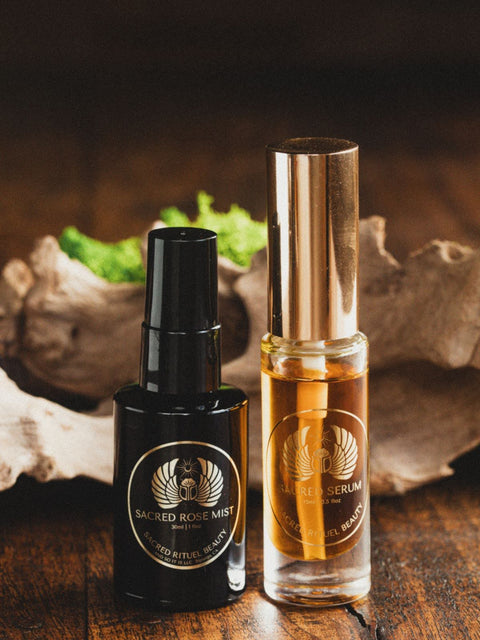
Sun Damage: How To Tell If It's Freckles Or Age Spots And What To Do About It
Key Takeaways:
- Differentiating Spots: Freckles and age spots both result from sun exposure, but they differ in size, color, and permanence.
- Effective Ingredients: Natural serums with ingredients like rose hip oil and green tea can help fade freckles and age spots over time.
- Prevention is Key: Daily sunscreen and protective clothing are essential to prevent new sun damage and keep your skin healthy.
We all love a bit of sun, but too much exposure can leave behind more than just a tan. You might notice new spots appearing on your skin—some that look like freckles, and others that resemble age spots. But how can you tell the difference between them? And more importantly, what should you do about them?
At Sacred Rituel, we’ve dedicated ourselves to understanding the intricacies of skin health and how to nurture it naturally. With our knowledge and passion for skincare, we're here to help you understand and manage sun damage, empowering you to take the best possible care of your skin.
This article will guide you through the essentials of sun damage, help you differentiate between freckles and age spots, and offer practical tips for treating and preventing these skin changes.
Understanding Sun Damage: Freckles Vs. Age Spots
Freckles and age spots are both forms of hyperpigmentation that appear due to sun exposure, but they’re not quite the same thing. Freckles, also known as ephelides, are usually small, flat, and tend to appear in clusters. They often show up in childhood and can fade during the winter months when sun exposure is lower. People with lighter skin tones and red or blonde hair are more prone to developing freckles, although anyone can get them.
Age spots, on the other hand, are larger, more defined areas of pigmentation that develop over time, usually after the age of 40. Also called liver spots or solar lentigines, age spots tend to persist year-round and are often found on areas like the face, hands, shoulders, and arms—places that get a lot of sun exposure over the years.
Freckles and age spots, though different, are both forms of hyperpigmentation that can benefit from targeted skincare. Our Sacred Serum Roller, with its blend of rose hip and pomegranate seed oils, helps to naturally lighten areas of pigmentation while nourishing the skin. Apply it daily to support a more even complexion and embrace your skin’s natural radiance—discover the transformative effects of Sacred Serum Roller today!
Why Do Freckles And Age Spots Form?
Freckles and age spots are both caused by the skin’s response to ultraviolet (UV) radiation from the sun. When your skin is exposed to sunlight, it produces more melanin, the pigment that gives your skin its color, as a way to protect itself. This increase in melanin can result in various forms of pigmentation, like freckles and age spots.
Freckles tend to form in response to short bursts of sun exposure, especially in people with a genetic predisposition to them. They are essentially clusters of melanin that appear on the skin’s surface. The formation of freckles is often a genetic trait and tends to be more common in individuals with fair skin.
Age spots, however, are more closely linked to cumulative sun exposure over time. As you age, your skin’s ability to regenerate and repair itself decreases. This leads to the development of larger, more permanent patches of pigmentation, commonly known as age spots. Essentially, these spots are a sign of your skin’s history of sun exposure and how it has changed over the years.
In both cases, UV exposure is the primary culprit, which is why wearing sunscreen and taking other protective measures is key to preventing these spots from forming.
How To Tell The Difference Between Freckles And Age Spots
At first glance, freckles and age spots might look similar, but there are a few key differences that can help you tell them apart. Here’s what to look for:
Size And Shape
Freckles are typically small and tend to cluster together, creating a speckled appearance on the skin. These spots are often no bigger than the head of a pin, giving them a delicate and scattered look. In contrast, age spots are larger and more defined, appearing as single, standalone spots that are more spread out on the skin.

Color
Freckles can range in color from light tan to dark brown and sometimes even have a reddish tint, depending on your skin tone and the amount of sun exposure. They often vary in color across the face, contributing to a less uniform appearance. Age spots, on the other hand, are generally a consistent shade of brown or black and tend to be more uniform in color, making them easier to identify as individual spots.
Location On The Body
Freckles most commonly show up on areas frequently exposed to the sun, such as the face, shoulders, and upper arms. They’re more likely to appear in these areas due to even brief periods of sun exposure, particularly in fair-skinned individuals. Age spots are more commonly found on areas with accumulated sun exposure over the years, such as the face, hands, forearms, and shoulders, where they can develop due to prolonged sun exposure.
Persistence
Freckles are often seasonal, becoming more pronounced during the summer months and fading or becoming less noticeable in the winter when sun exposure decreases. They’re influenced by UV exposure, which can cause them to darken temporarily but fade when exposure is reduced. Age spots are generally more permanent; once they form, they don’t fluctuate with changes in seasons and remain visible year-round without fading.
Treatment Options: How To Address Freckles And Age Spots
If you’re looking to fade freckles and age spots, serums containing specific natural ingredients can be quite effective. Here’s a breakdown of how some of these powerful botanicals work:
Rose Hip Seed Oil
Rich in both vitamins A and C, rose hip seed oil is renowned for its ability to brighten the skin and reduce pigmentation. The vitamin C in this oil promotes collagen production and enhances skin cell turnover, which can help lighten freckles and age spots over time. Additionally, its moisturizing properties support overall skin health, leaving the skin smooth and supple.
Sea Buckthorn Fruit Oil
Sea buckthorn fruit oil is loaded with antioxidants, including vitamins C and E, which work together to repair skin damage from UV exposure. The oil’s anti-inflammatory properties help soothe irritated or sun-damaged skin, making it ideal for those with sensitive or reactive skin types. This nourishing oil also aids in balancing skin tone, which can reduce the visibility of freckles and age spots.
Pomegranate Seed Oil
Packed with antioxidants, pomegranate seed oil contains punicic acid, which helps protect skin cells and promote regeneration. This oil not only assists in reducing visible signs of sun damage like age spots but also improves skin elasticity, making it an excellent choice for mature skin. The oil’s rich composition also helps hydrate and replenish the skin, adding a healthy glow.
Amla Fruit Oil
Amla fruit oil, derived from the Indian gooseberry, is a potent source of vitamin C, which is crucial for brightening the skin and reducing pigmentation. Its antioxidant properties help combat free radicals, which can cause sun damage and lead to dark spots. By inhibiting melanin production, amla oil helps to gradually fade freckles and age spots, revealing a more even complexion.
Frankincense Extract
Known for its ability to rejuvenate the skin, frankincense extract helps reduce the appearance of dark spots and smooths out uneven skin tone. This ingredient is especially beneficial for those with mature skin, as it helps to promote cell turnover and elasticity, reducing the appearance of age spots. Its calming properties also make it suitable for sensitive skin, providing a gentle yet effective approach to pigmentation issues.
When To See A Dermatologist For Sun Damage
While freckles and age spots are generally harmless, there are times when it’s a good idea to consult with a dermatologist, especially if you’re concerned about any changes to your skin. Here’s when to consider making an appointment:
- Rapid Changes in Size, Shape, or Color: If you notice any freckle or age spot that suddenly grows, changes shape, or becomes darker, it’s worth getting it checked. These changes could indicate something more serious, like skin cancer, so it’s important not to ignore them.
- New Spots That Appear Later in Life: While freckles often appear in childhood, age spots usually show up as we get older. If you suddenly develop new spots in areas not previously affected by sun damage, a dermatologist can help determine if they’re harmless or require treatment.
- Itching, Pain, or Bleeding: If any spot on your skin becomes itchy, painful, or starts to bleed, it’s wise to have a dermatologist examine it. These symptoms are not typical of regular freckles or age spots and could signal an underlying issue.
Regular skin check-ups can also be a proactive way to monitor sun damage and catch any potential issues early. Dermatologists have the tools and expertise to assess your skin thoroughly, helping you maintain skin health and peace of mind.
Prevention Tips: Protecting Your Skin From Sun Damage
Preventing sun damage is key to minimizing freckles and age spots over the long term. Here are some effective ways to protect your skin:
Use Sunscreen Daily
Applying a broad-spectrum sunscreen with at least SPF 30 is one of the best ways to prevent sun damage. Make it a daily habit, even on cloudy days or when you’re indoors, as UV rays can penetrate through windows. Reapply every two hours if you’re outside for extended periods.
Wear Protective Clothing
Opting for wide-brimmed hats, long-sleeved shirts, and sunglasses with UV protection helps create a physical barrier against the sun’s rays. Specialized clothing with built-in UV protection offers additional defense, especially if you’re outdoors for long stretches. Covering up reduces direct sun exposure, significantly lowering the risk of sunburn and the development of new freckles and age spots.
Seek Shade During Peak Hours
The sun is at its most intense between 10 a.m. and 4 p.m., which increases the likelihood of sunburn and long-term skin damage. If you need to be outside during these hours, try to find shaded areas, or bring a sun umbrella to create your own shade. Limiting direct sun exposure during peak hours can drastically reduce your overall UV exposure and protect your skin from damage.
Avoid Tanning Beds
Tanning beds emit concentrated UV radiation that penetrates the skin deeply, accelerating the formation of freckles, age spots, and other signs of aging. Instead of using tanning beds, which increase the risk of skin cancer, consider using sunless tanning products for a safer alternative. Embracing your natural skin tone can also help prevent unnecessary UV exposure and the associated skin damage.
Incorporate Antioxidants Into Your Routine
Antioxidants play a vital role in neutralizing free radicals caused by UV exposure, which can prevent further damage and aid in skin repair. Incorporating antioxidant-rich foods like berries, spinach, and nuts into your diet can boost your skin’s defense against sun damage from the inside out. Topical antioxidants, such as serums with sources of Vitamin C, can also help protect the skin and improve its resilience to UV exposure.

Final Thoughts
Freckles and age spots are common signs of sun exposure, and while they’re usually harmless, they can sometimes be a source of concern or curiosity. Understanding the differences between the two, along with knowing how to treat and prevent them, can help you make informed decisions about your skin’s health.
With the right serums and skincare routine, you can effectively manage existing freckles and age spots, and by practicing good sun protection habits, you’ll be well on your way to minimizing further damage. Remember, if you ever have concerns about a spot on your skin, it’s always wise to consult a dermatologist for a professional opinion.
Taking care of your skin is a lifelong journey, and a few mindful steps each day can make all the difference. Here’s to keeping your skin healthy, protected, and glowing!
Read also:
- The Complete Guide To Holistic Skincare Practices
- Repair Sun-Damaged Skin Naturally With These Facial Toner Tips
- How To Treat Hyperpigmentation Around The Mouth
Frequently Asked Questions About Freckles, Age Spots, And Sun Damage
Can freckles turn into age spots?
Freckles do not turn into age spots, but prolonged sun exposure can lead to the formation of age spots in addition to freckles.
Are age spots a sign of skin cancer?
Age spots themselves are not cancerous, but any spot that changes rapidly in color, size, or shape should be checked by a dermatologist.
Do freckles go away with age?
Freckles may become less noticeable with age and reduced sun exposure, but they often persist throughout life, especially with continued sun exposure.
Is it possible to prevent freckles entirely?
Freckles can be minimized but not entirely prevented, especially if you have a genetic predisposition. Regular use of sunscreen and sun protection can reduce their appearance.
Do freckles mean my skin is damaged?
Freckles are a natural reaction to sun exposure and don’t necessarily mean your skin is damaged, but they do indicate sensitivity to UV rays.
What’s the difference between age spots and melanoma?
Age spots are benign and have a uniform color and shape, while melanoma may be irregular in shape, have multiple colors, and may grow over time.
Do freckles and age spots affect only certain skin types?
While anyone can develop freckles or age spots, people with fair skin are more prone to freckles, and age spots commonly affect those with long-term sun exposure.
Do men get freckles and age spots too?
Yes, freckles and age spots can affect anyone, regardless of gender, although they are more visible on fairer skin tones.
Can freckles darken or multiply?
Freckles can darken and increase in number with more sun exposure, especially during the summer months.
Are age spots hereditary?
While age spots are primarily due to sun exposure, genetics can influence how prone you are to developing them.
Sources:
- Kiralan, M., & Yildirim, G. (2019). Rosehip (Rosa canina L.) oil. Fruit Oils: Chemistry and Functionality, 803-814.
- Gęgotek, A., Jastrząb, A., Jarocka-Karpowicz, I., Muszyńska, M., & Skrzydlewska, E. (2018). The effect of sea buckthorn (Hippophae rhamnoides L.) seed oil on UV-induced changes in lipid metabolism of human skin cells. Antioxidants, 7(9), 110.
- Afaq, F., Zaid, M. A., Khan, N., Dreher, M., & Mukhtar, H. (2009). Protective effect of pomegranate‐derived products on UVB‐mediated damage in human reconstituted skin. Experimental dermatology, 18(6), 553-561.

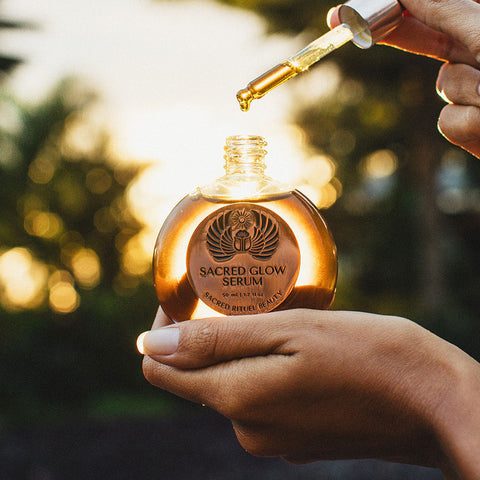

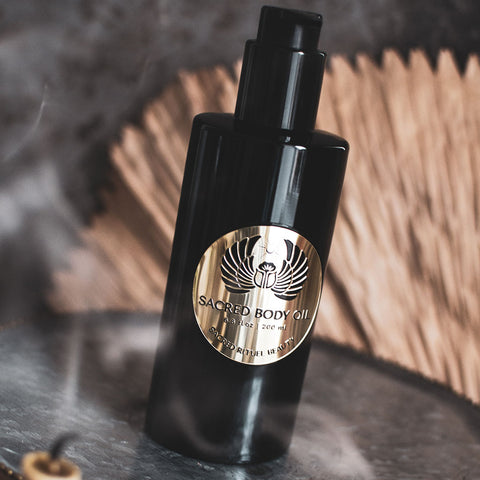
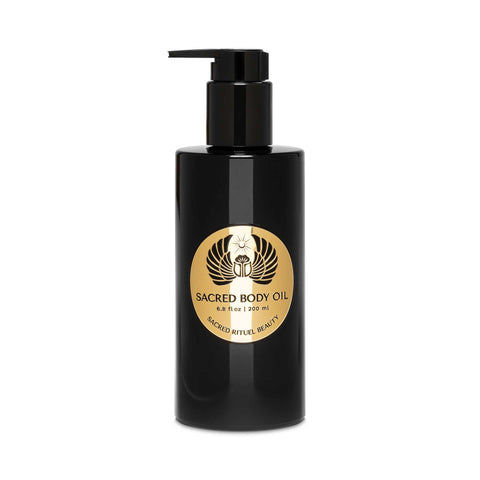
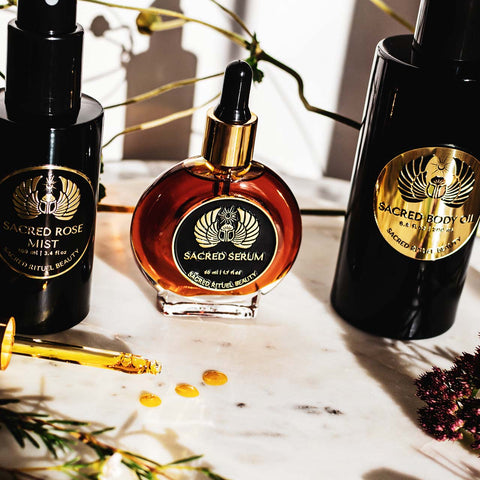
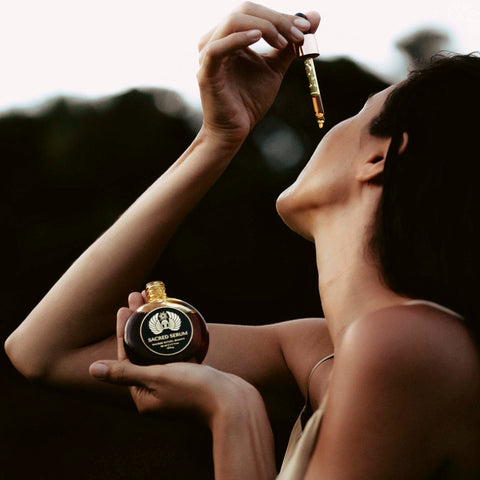
Comments (0)
There are no comments for this article. Be the first one to leave a message!